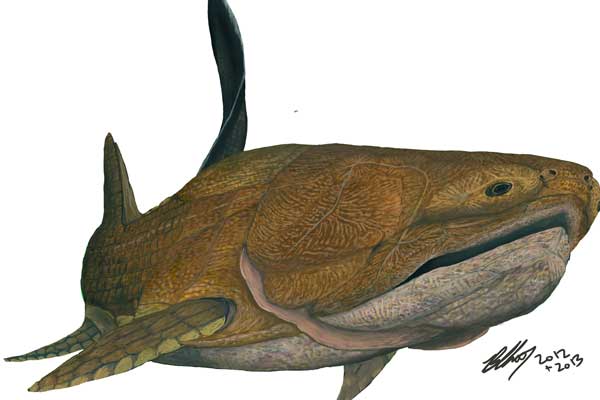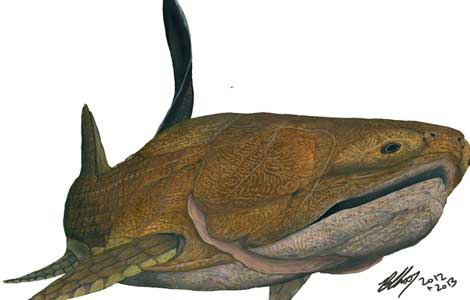Early fish ancestor found
Updated: 2013-09-27 00:16
By Cheng Yingqi (China Daily)
|
||||||||
Fossilized sea creature shows bony armor and complex facial structure
The fossilized remains of a 419-million-year-old fish that could be the most primitive known creature with "what we would recognize as a face" has been discovered in China, scientists reported in an article in Nature on Thursday.
The fish, Entelognathus primordialis, literally "the primordial complete jaw", was a heavily armored creature about 20 centimeters in length with small eyes and toothless jaws.
 |
|
The fossilized remains of an early fish, Entelognathus primordialis, has the same basic configuration seen in human skulls. photos provided to china daily |
An international team of researchers led by Zhu Min from the Institute of Vertebrate Paleontology and Paleoanthropology at the Chinese Academy of Sciences unearthed the fossil in 2010 in Yunnan province. During the Late Silurian Period, when Entelognathus lived, the region was submerged beneath a warm coastal sea.
At first glance, Entelognathus appears to be a typical arthrodiran placoderm, an extinct group of armored fish from the Silurian and Devonian Periods (4.35 million years to 3.6 million years ago). They are generally recognized as the most primitive of jawed vertebrates.
When researchers closely examined the head of the fossilized fish, they found something bizarre and significant.
Brian Choo, a researcher from the institute who also worked on the project, said, "While all other known placoderms had simple jaws and cheeks made from a few large bones, Entelognathus has a more complex arrangement of smaller bones, including a maxilla and premaxilla on the upper jaw and a dentary on the lower jaw, as well as multiple cheek elements."
This configuration was identical to that seen in bony vertebrates, including bony fishes and all the limbed vertebrates.
"Indeed, it is the same basic configuration seen in our own human skulls," Choo said.
More clues were found when the scientists looked inside the head of Entelognathus and found anatomy between that of placoderms and modern jawed vertebrates.
"That means, though we used to think the common ancestor of modern jawed vertebrates had a look like sharks, we could be wrong," Zhu said.
The new evidence showed that the most recent common ancestor of all modern jawed vertebrates was an armored placoderm: a small fish that had bony armor covering its head and body as well as a modern bony face.
The armored placoderm then developed into two branches: the bone armor greatly reduced in the branch that led to sharks; and the bony skeleton was retained and refined in the line leading to bony fish and limbed vertebrates.
"In this case, our distant ancestors didn't develop their bony skeletons from scratch; they simply inherited them from their armored ancestors," Zhu said.

 US astronaut praises China's space program
US astronaut praises China's space program
 Christie's holds inaugural auction
Christie's holds inaugural auction
 Aviation gains from exchanges
Aviation gains from exchanges
 Early fish ancestor found
Early fish ancestor found
 Singers' son sentenced to 10 years for rape
Singers' son sentenced to 10 years for rape
 Djokovic announces engagement to girlfriend
Djokovic announces engagement to girlfriend
 Taipei, LA and Singapore top travel search growth list
Taipei, LA and Singapore top travel search growth list
 Big cats are part of the family
Big cats are part of the family
Most Viewed
Editor's Picks

|

|

|

|

|

|
Today's Top News
Russia to guard Syria chemical weapon destruction
Interpol issues arrest notice for 'white widow'
US astronaut praises China's space program
Joint talks on trade in services
Philippines-US drill raises concern
Abe blames China for defense spending
Courier reaches for the sky with drone
President Xi touts moral models
US Weekly

|

|





